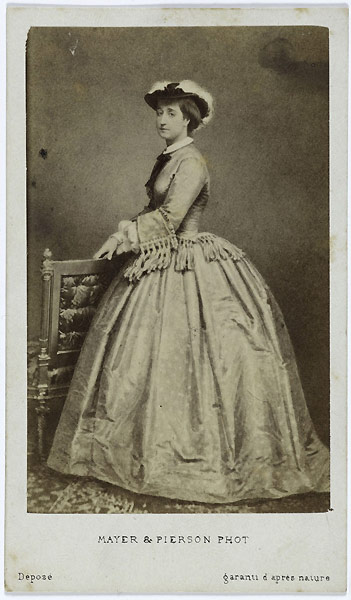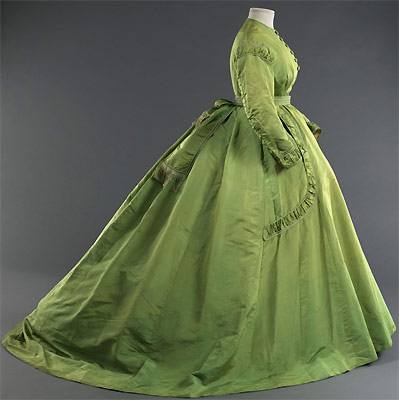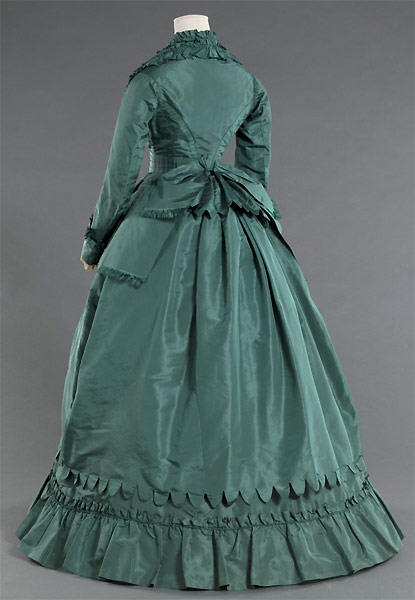
beautyme collections culture cuisine motor music search
 The Empire of the Crinoline (1852-1870)
The Empire of the Crinoline (1852-1870)
Sous l’Empire des crinolines 1852-1870
29 November 2008 – 26 April 2009
Musée Galliera, Paris
www.galliera.paris.fr
From an underskirt to the "Cul de Paris"
Chief curator and director of the Musée Galliera Catherine Join-Diéterle and the fashion historian Françoise Vittu explore fashion under France's Second
Empire from 1852 to 1870 and focus on one significant piece of that time: the crinoline that was originally an underskirt stiffened with horsehair (in French "crin"), and became in 1859 a domed cage of metal hoops up to 180 centimetres (6 ft) in diameter. Its shape
evolved, with the fullness moving to the back of the skirt, and the bustle appeared in 1867.
The crinoline was the last fashion piece in Western history that deformed the silhouette of a woman so massively; probably this piece was the reason why the "Rational Dress" had so much success in the following years.
The curators lead with costumes, photographs, prints ... through 4 sections.
The exhibition welcomes you with a Ball Scene. Mantelets, crinoline dresses, dance
cards, fans, flower holders and hair ornaments give an impression how women dresses at that time. Some of the pieces belonged to
Empress Eugénie, the fashion leader of that time.
fig.: L’Impératrice Eugénie, vers 1861. Photographie de Mayer & Pierson. © Stéphane Piera / Galliera / Roger-Viollet.
 Until Eugénie uses the color green for her wardrobe, a green dress has been one of the big "NoNos" in fashion. Green was not a prestigious color, because it was cheap in production; colored with plants, fabrics in green were affordable for the great masses. But the green of
Empress Eugénie's dress was new: it glows magical (phosphor) in the light of the gas light. The time of chemical dying has began to enter the world of fashion after the "most beautiful" woman of the world wears phosphorizing green (invented in 1863).
Until Eugénie uses the color green for her wardrobe, a green dress has been one of the big "NoNos" in fashion. Green was not a prestigious color, because it was cheap in production; colored with plants, fabrics in green were affordable for the great masses. But the green of
Empress Eugénie's dress was new: it glows magical (phosphor) in the light of the gas light. The time of chemical dying has began to enter the world of fashion after the "most beautiful" woman of the world wears phosphorizing green (invented in 1863).
fig.: Ensemble d’été, vers 1867. Toile de lin beige, soutaches et galons noirs. © Stéphane Piera / Galliera / Roger-Viollet.
In the 2nd section "Modern Life" samples of city and holiday wear such as capes,
dresses, boleros, the "petites costumes" that were forerunners of the suit, and all the vital
accessories: shawls, parasols, hats, ankle boots, etc. are shown. Society was following the global trend
towards modernisation – city planning, industry, railways – and taking its holidays in the
mountains, seaside resorts and spa towns.
 The 3rd section is about making and marketing of fashion wear: in
1857 Haute Couture was founded by Charles Frederick Worth who was the most important couturiers for dresses with crinolines that move back of the skirt, also known as the "cul de Paris".
The 3rd section is about making and marketing of fashion wear: in
1857 Haute Couture was founded by Charles Frederick Worth who was the most important couturiers for dresses with crinolines that move back of the skirt, also known as the "cul de Paris".
fig.: Robe de jour griffée Worth & Bobergh, vers 1869. Faille de soie verte. © Stéphane Piera / Galliera / Roger-Viollet.
In the same time department stores like Au Louvre, Au Bon Marché or Au Printemps were booming. Then there were the Universal Expositions of 1855 and 1867, reflections of a Paris that was an international showcase for excellence.
In the last section Paris is celebrated as the shining symbol of the capital of luxury and elegance with exclusive jewellery pieces by famous houses such as Cartier and
Boucheron.
more culture>>>